Technical Report: Designing Vertical Drainage Using Wick Drains
VerifiedAdded on 2023/06/13
|19
|4098
|421
Report
AI Summary
This technical report provides a detailed overview of designing vertical drainage systems using prefabricated vertical drains (PVDs), commonly known as wick drains, to enhance radial drainage and soil consolidation. It delves into essential techniques such as lateral permeability reduction, the effects of smear zones overlapping, and undrained shear strength gain after consolidation. The report illustrates vertical drain construction methodologies, offering practitioners a broader perspective on solving soil consolidation challenges. It covers aspects of vertical drain consolidation, factors influencing consolidation time, and the evolution of vertical drains from sand drains to wick drains. The design procedures for both simplified single-stage loading and multi-stage loading embankments are discussed, providing a comprehensive guide for engineers and construction professionals. Desklib provides access to a wealth of study resources, including past papers and solved assignments, to support students and professionals in their academic and practical endeavors.

DESIGN VERTICAL DRAINAGE USING WICK DRAIN.
By Name
Course
Instructor
Institution
Location
Date
Designing Vertical Drainage Using Wick Drains. 1
By Name
Course
Instructor
Institution
Location
Date
Designing Vertical Drainage Using Wick Drains. 1
Paraphrase This Document
Need a fresh take? Get an instant paraphrase of this document with our AI Paraphraser
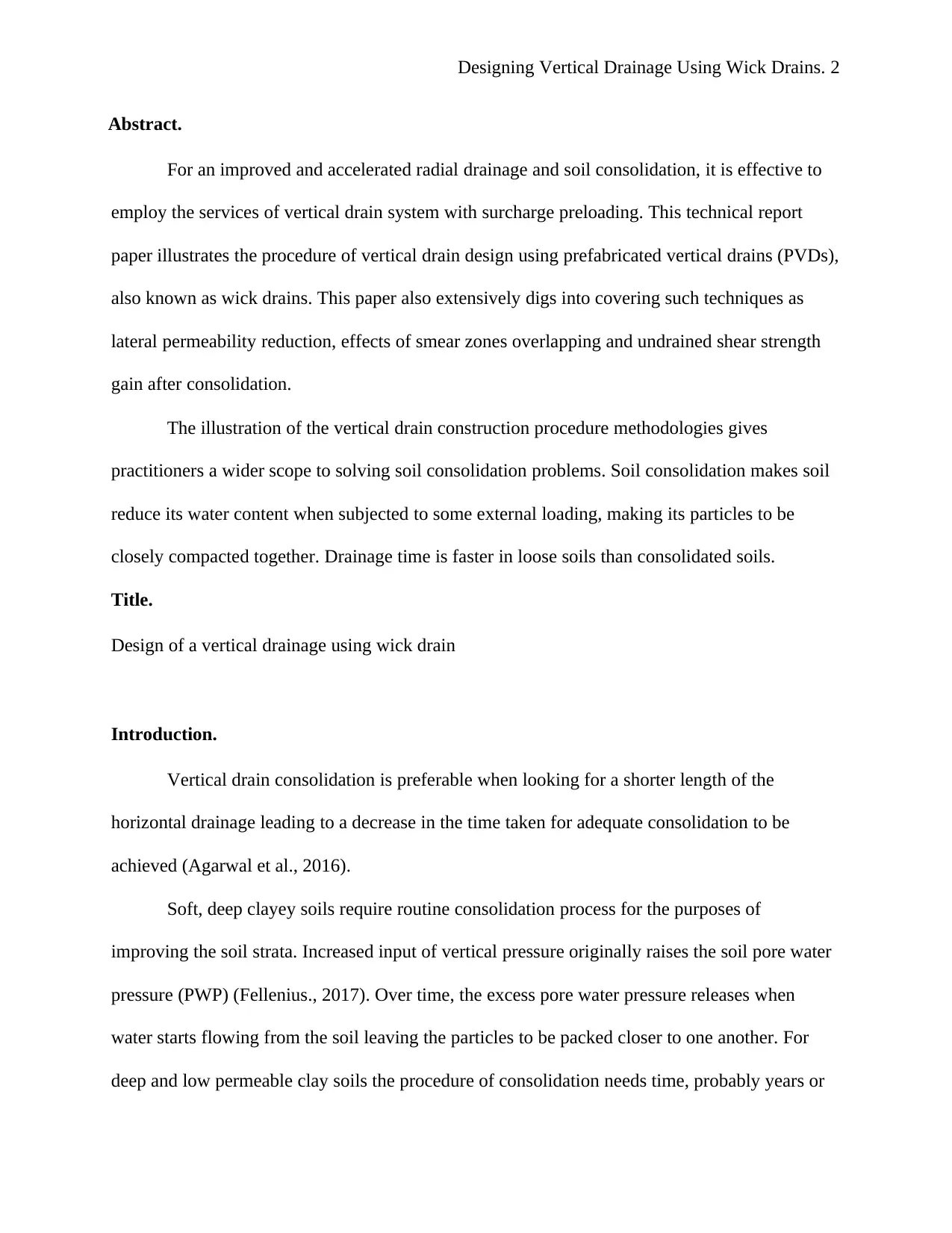
Abstract.
For an improved and accelerated radial drainage and soil consolidation, it is effective to
employ the services of vertical drain system with surcharge preloading. This technical report
paper illustrates the procedure of vertical drain design using prefabricated vertical drains (PVDs),
also known as wick drains. This paper also extensively digs into covering such techniques as
lateral permeability reduction, effects of smear zones overlapping and undrained shear strength
gain after consolidation.
The illustration of the vertical drain construction procedure methodologies gives
practitioners a wider scope to solving soil consolidation problems. Soil consolidation makes soil
reduce its water content when subjected to some external loading, making its particles to be
closely compacted together. Drainage time is faster in loose soils than consolidated soils.
Title.
Design of a vertical drainage using wick drain
Introduction.
Vertical drain consolidation is preferable when looking for a shorter length of the
horizontal drainage leading to a decrease in the time taken for adequate consolidation to be
achieved (Agarwal et al., 2016).
Soft, deep clayey soils require routine consolidation process for the purposes of
improving the soil strata. Increased input of vertical pressure originally raises the soil pore water
pressure (PWP) (Fellenius., 2017). Over time, the excess pore water pressure releases when
water starts flowing from the soil leaving the particles to be packed closer to one another. For
deep and low permeable clay soils the procedure of consolidation needs time, probably years or
Designing Vertical Drainage Using Wick Drains. 2
For an improved and accelerated radial drainage and soil consolidation, it is effective to
employ the services of vertical drain system with surcharge preloading. This technical report
paper illustrates the procedure of vertical drain design using prefabricated vertical drains (PVDs),
also known as wick drains. This paper also extensively digs into covering such techniques as
lateral permeability reduction, effects of smear zones overlapping and undrained shear strength
gain after consolidation.
The illustration of the vertical drain construction procedure methodologies gives
practitioners a wider scope to solving soil consolidation problems. Soil consolidation makes soil
reduce its water content when subjected to some external loading, making its particles to be
closely compacted together. Drainage time is faster in loose soils than consolidated soils.
Title.
Design of a vertical drainage using wick drain
Introduction.
Vertical drain consolidation is preferable when looking for a shorter length of the
horizontal drainage leading to a decrease in the time taken for adequate consolidation to be
achieved (Agarwal et al., 2016).
Soft, deep clayey soils require routine consolidation process for the purposes of
improving the soil strata. Increased input of vertical pressure originally raises the soil pore water
pressure (PWP) (Fellenius., 2017). Over time, the excess pore water pressure releases when
water starts flowing from the soil leaving the particles to be packed closer to one another. For
deep and low permeable clay soils the procedure of consolidation needs time, probably years or
Designing Vertical Drainage Using Wick Drains. 2
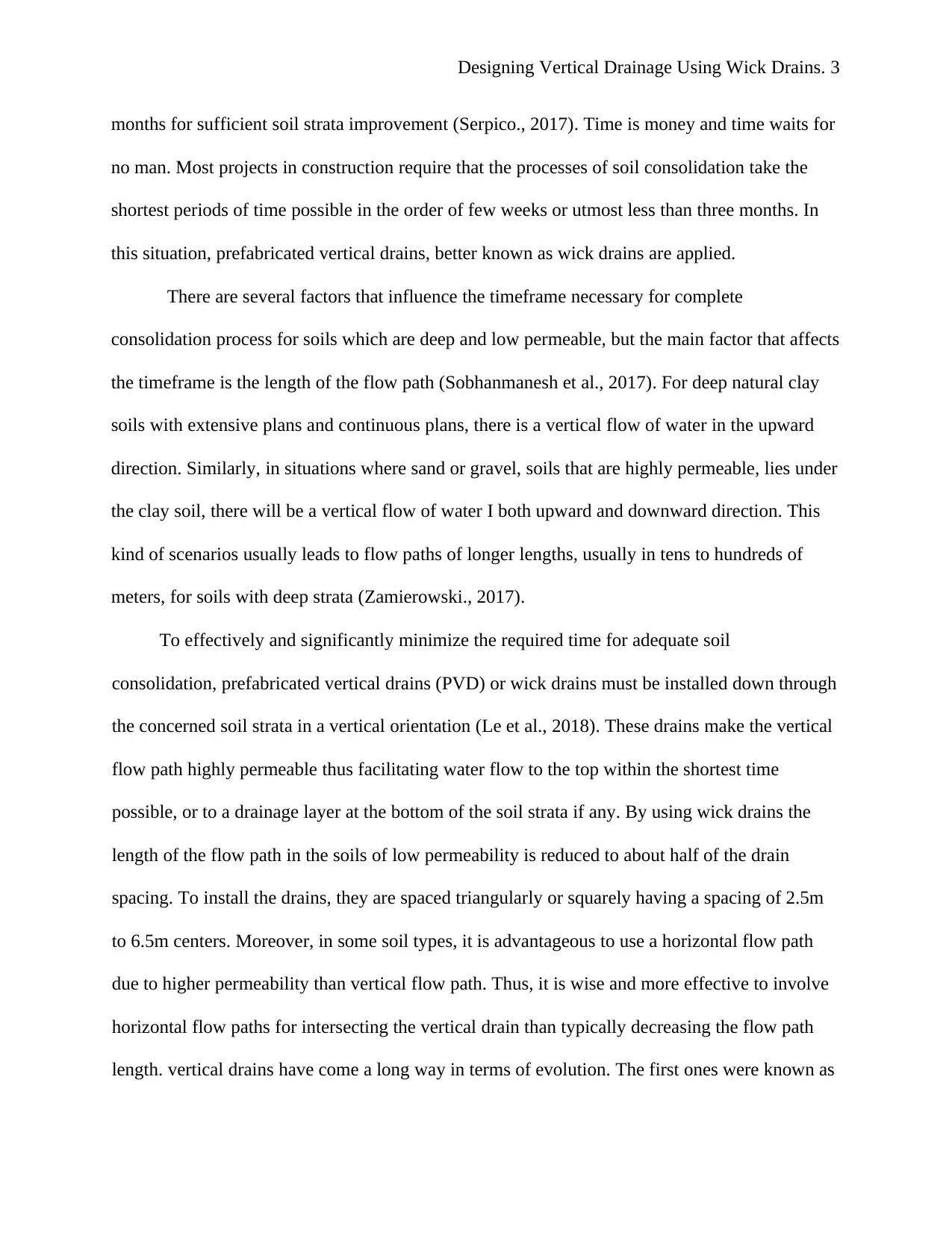
months for sufficient soil strata improvement (Serpico., 2017). Time is money and time waits for
no man. Most projects in construction require that the processes of soil consolidation take the
shortest periods of time possible in the order of few weeks or utmost less than three months. In
this situation, prefabricated vertical drains, better known as wick drains are applied.
There are several factors that influence the timeframe necessary for complete
consolidation process for soils which are deep and low permeable, but the main factor that affects
the timeframe is the length of the flow path (Sobhanmanesh et al., 2017). For deep natural clay
soils with extensive plans and continuous plans, there is a vertical flow of water in the upward
direction. Similarly, in situations where sand or gravel, soils that are highly permeable, lies under
the clay soil, there will be a vertical flow of water I both upward and downward direction. This
kind of scenarios usually leads to flow paths of longer lengths, usually in tens to hundreds of
meters, for soils with deep strata (Zamierowski., 2017).
To effectively and significantly minimize the required time for adequate soil
consolidation, prefabricated vertical drains (PVD) or wick drains must be installed down through
the concerned soil strata in a vertical orientation (Le et al., 2018). These drains make the vertical
flow path highly permeable thus facilitating water flow to the top within the shortest time
possible, or to a drainage layer at the bottom of the soil strata if any. By using wick drains the
length of the flow path in the soils of low permeability is reduced to about half of the drain
spacing. To install the drains, they are spaced triangularly or squarely having a spacing of 2.5m
to 6.5m centers. Moreover, in some soil types, it is advantageous to use a horizontal flow path
due to higher permeability than vertical flow path. Thus, it is wise and more effective to involve
horizontal flow paths for intersecting the vertical drain than typically decreasing the flow path
length. vertical drains have come a long way in terms of evolution. The first ones were known as
Designing Vertical Drainage Using Wick Drains. 3
no man. Most projects in construction require that the processes of soil consolidation take the
shortest periods of time possible in the order of few weeks or utmost less than three months. In
this situation, prefabricated vertical drains, better known as wick drains are applied.
There are several factors that influence the timeframe necessary for complete
consolidation process for soils which are deep and low permeable, but the main factor that affects
the timeframe is the length of the flow path (Sobhanmanesh et al., 2017). For deep natural clay
soils with extensive plans and continuous plans, there is a vertical flow of water in the upward
direction. Similarly, in situations where sand or gravel, soils that are highly permeable, lies under
the clay soil, there will be a vertical flow of water I both upward and downward direction. This
kind of scenarios usually leads to flow paths of longer lengths, usually in tens to hundreds of
meters, for soils with deep strata (Zamierowski., 2017).
To effectively and significantly minimize the required time for adequate soil
consolidation, prefabricated vertical drains (PVD) or wick drains must be installed down through
the concerned soil strata in a vertical orientation (Le et al., 2018). These drains make the vertical
flow path highly permeable thus facilitating water flow to the top within the shortest time
possible, or to a drainage layer at the bottom of the soil strata if any. By using wick drains the
length of the flow path in the soils of low permeability is reduced to about half of the drain
spacing. To install the drains, they are spaced triangularly or squarely having a spacing of 2.5m
to 6.5m centers. Moreover, in some soil types, it is advantageous to use a horizontal flow path
due to higher permeability than vertical flow path. Thus, it is wise and more effective to involve
horizontal flow paths for intersecting the vertical drain than typically decreasing the flow path
length. vertical drains have come a long way in terms of evolution. The first ones were known as
Designing Vertical Drainage Using Wick Drains. 3
⊘ This is a preview!⊘
Do you want full access?
Subscribe today to unlock all pages.

Trusted by 1+ million students worldwide
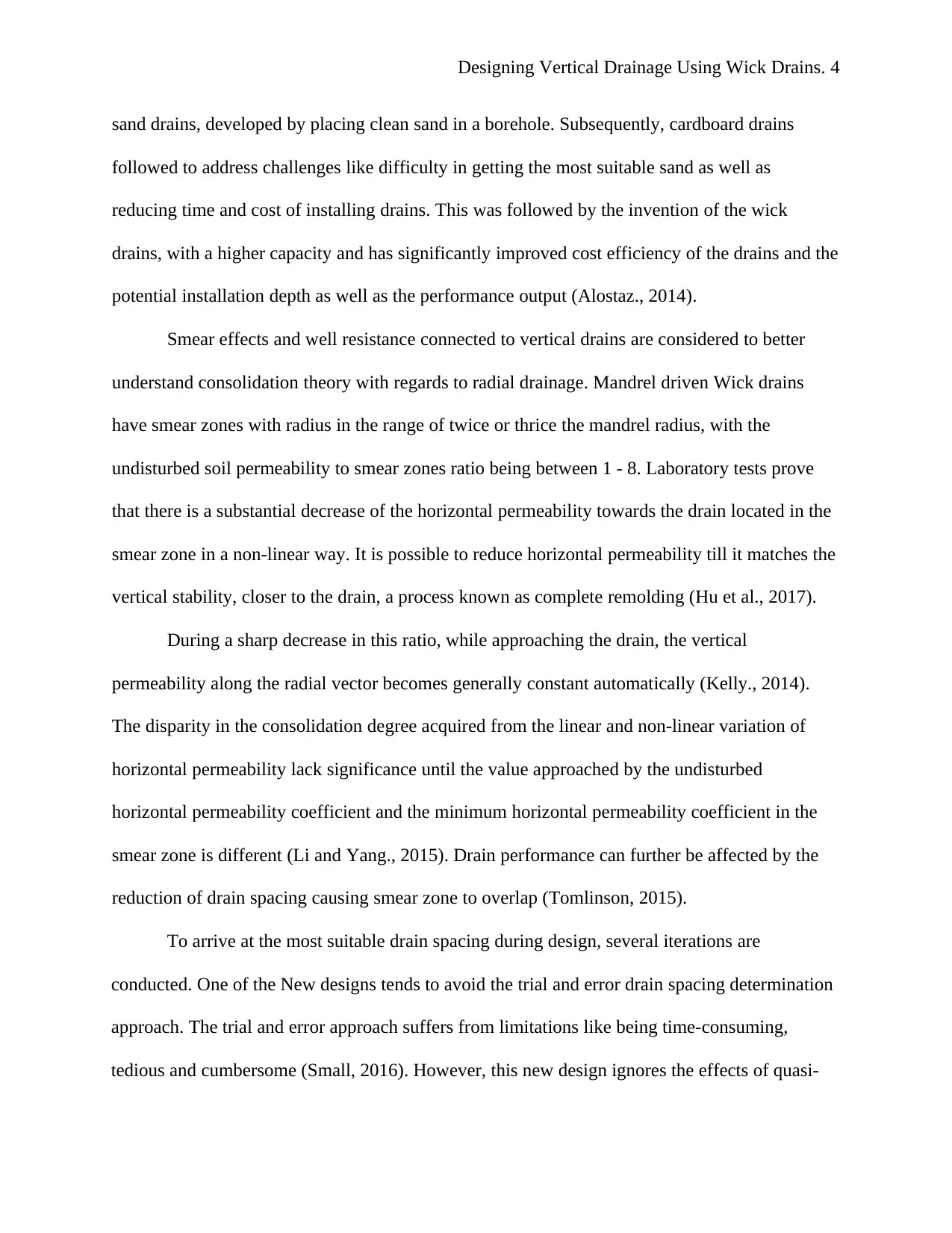
sand drains, developed by placing clean sand in a borehole. Subsequently, cardboard drains
followed to address challenges like difficulty in getting the most suitable sand as well as
reducing time and cost of installing drains. This was followed by the invention of the wick
drains, with a higher capacity and has significantly improved cost efficiency of the drains and the
potential installation depth as well as the performance output (Alostaz., 2014).
Smear effects and well resistance connected to vertical drains are considered to better
understand consolidation theory with regards to radial drainage. Mandrel driven Wick drains
have smear zones with radius in the range of twice or thrice the mandrel radius, with the
undisturbed soil permeability to smear zones ratio being between 1 - 8. Laboratory tests prove
that there is a substantial decrease of the horizontal permeability towards the drain located in the
smear zone in a non-linear way. It is possible to reduce horizontal permeability till it matches the
vertical stability, closer to the drain, a process known as complete remolding (Hu et al., 2017).
During a sharp decrease in this ratio, while approaching the drain, the vertical
permeability along the radial vector becomes generally constant automatically (Kelly., 2014).
The disparity in the consolidation degree acquired from the linear and non-linear variation of
horizontal permeability lack significance until the value approached by the undisturbed
horizontal permeability coefficient and the minimum horizontal permeability coefficient in the
smear zone is different (Li and Yang., 2015). Drain performance can further be affected by the
reduction of drain spacing causing smear zone to overlap (Tomlinson, 2015).
To arrive at the most suitable drain spacing during design, several iterations are
conducted. One of the New designs tends to avoid the trial and error drain spacing determination
approach. The trial and error approach suffers from limitations like being time-consuming,
tedious and cumbersome (Small, 2016). However, this new design ignores the effects of quasi-
Designing Vertical Drainage Using Wick Drains. 4
followed to address challenges like difficulty in getting the most suitable sand as well as
reducing time and cost of installing drains. This was followed by the invention of the wick
drains, with a higher capacity and has significantly improved cost efficiency of the drains and the
potential installation depth as well as the performance output (Alostaz., 2014).
Smear effects and well resistance connected to vertical drains are considered to better
understand consolidation theory with regards to radial drainage. Mandrel driven Wick drains
have smear zones with radius in the range of twice or thrice the mandrel radius, with the
undisturbed soil permeability to smear zones ratio being between 1 - 8. Laboratory tests prove
that there is a substantial decrease of the horizontal permeability towards the drain located in the
smear zone in a non-linear way. It is possible to reduce horizontal permeability till it matches the
vertical stability, closer to the drain, a process known as complete remolding (Hu et al., 2017).
During a sharp decrease in this ratio, while approaching the drain, the vertical
permeability along the radial vector becomes generally constant automatically (Kelly., 2014).
The disparity in the consolidation degree acquired from the linear and non-linear variation of
horizontal permeability lack significance until the value approached by the undisturbed
horizontal permeability coefficient and the minimum horizontal permeability coefficient in the
smear zone is different (Li and Yang., 2015). Drain performance can further be affected by the
reduction of drain spacing causing smear zone to overlap (Tomlinson, 2015).
To arrive at the most suitable drain spacing during design, several iterations are
conducted. One of the New designs tends to avoid the trial and error drain spacing determination
approach. The trial and error approach suffers from limitations like being time-consuming,
tedious and cumbersome (Small, 2016). However, this new design ignores the effects of quasi-
Designing Vertical Drainage Using Wick Drains. 4
Paraphrase This Document
Need a fresh take? Get an instant paraphrase of this document with our AI Paraphraser
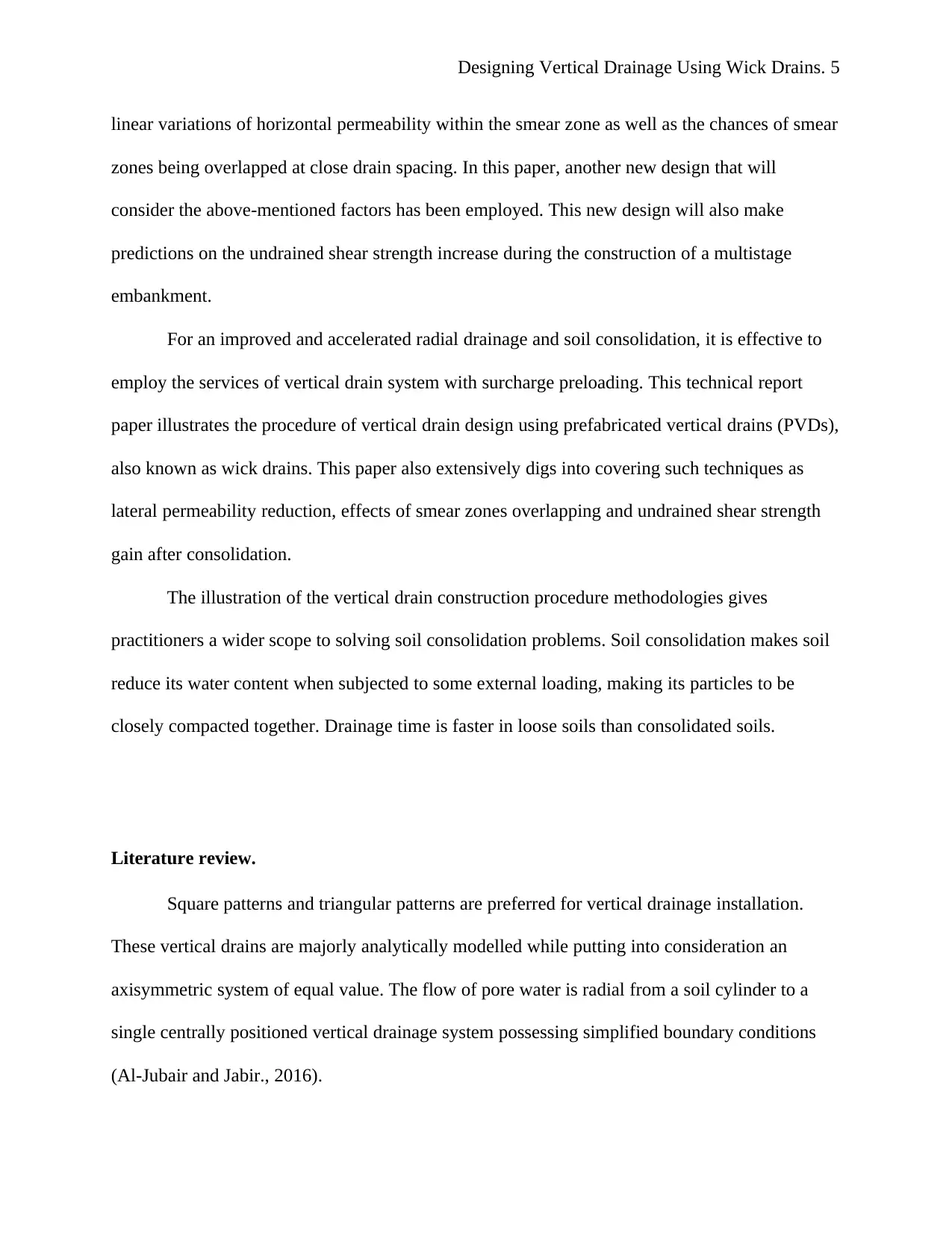
linear variations of horizontal permeability within the smear zone as well as the chances of smear
zones being overlapped at close drain spacing. In this paper, another new design that will
consider the above-mentioned factors has been employed. This new design will also make
predictions on the undrained shear strength increase during the construction of a multistage
embankment.
For an improved and accelerated radial drainage and soil consolidation, it is effective to
employ the services of vertical drain system with surcharge preloading. This technical report
paper illustrates the procedure of vertical drain design using prefabricated vertical drains (PVDs),
also known as wick drains. This paper also extensively digs into covering such techniques as
lateral permeability reduction, effects of smear zones overlapping and undrained shear strength
gain after consolidation.
The illustration of the vertical drain construction procedure methodologies gives
practitioners a wider scope to solving soil consolidation problems. Soil consolidation makes soil
reduce its water content when subjected to some external loading, making its particles to be
closely compacted together. Drainage time is faster in loose soils than consolidated soils.
Literature review.
Square patterns and triangular patterns are preferred for vertical drainage installation.
These vertical drains are majorly analytically modelled while putting into consideration an
axisymmetric system of equal value. The flow of pore water is radial from a soil cylinder to a
single centrally positioned vertical drainage system possessing simplified boundary conditions
(Al-Jubair and Jabir., 2016).
Designing Vertical Drainage Using Wick Drains. 5
zones being overlapped at close drain spacing. In this paper, another new design that will
consider the above-mentioned factors has been employed. This new design will also make
predictions on the undrained shear strength increase during the construction of a multistage
embankment.
For an improved and accelerated radial drainage and soil consolidation, it is effective to
employ the services of vertical drain system with surcharge preloading. This technical report
paper illustrates the procedure of vertical drain design using prefabricated vertical drains (PVDs),
also known as wick drains. This paper also extensively digs into covering such techniques as
lateral permeability reduction, effects of smear zones overlapping and undrained shear strength
gain after consolidation.
The illustration of the vertical drain construction procedure methodologies gives
practitioners a wider scope to solving soil consolidation problems. Soil consolidation makes soil
reduce its water content when subjected to some external loading, making its particles to be
closely compacted together. Drainage time is faster in loose soils than consolidated soils.
Literature review.
Square patterns and triangular patterns are preferred for vertical drainage installation.
These vertical drains are majorly analytically modelled while putting into consideration an
axisymmetric system of equal value. The flow of pore water is radial from a soil cylinder to a
single centrally positioned vertical drainage system possessing simplified boundary conditions
(Al-Jubair and Jabir., 2016).
Designing Vertical Drainage Using Wick Drains. 5
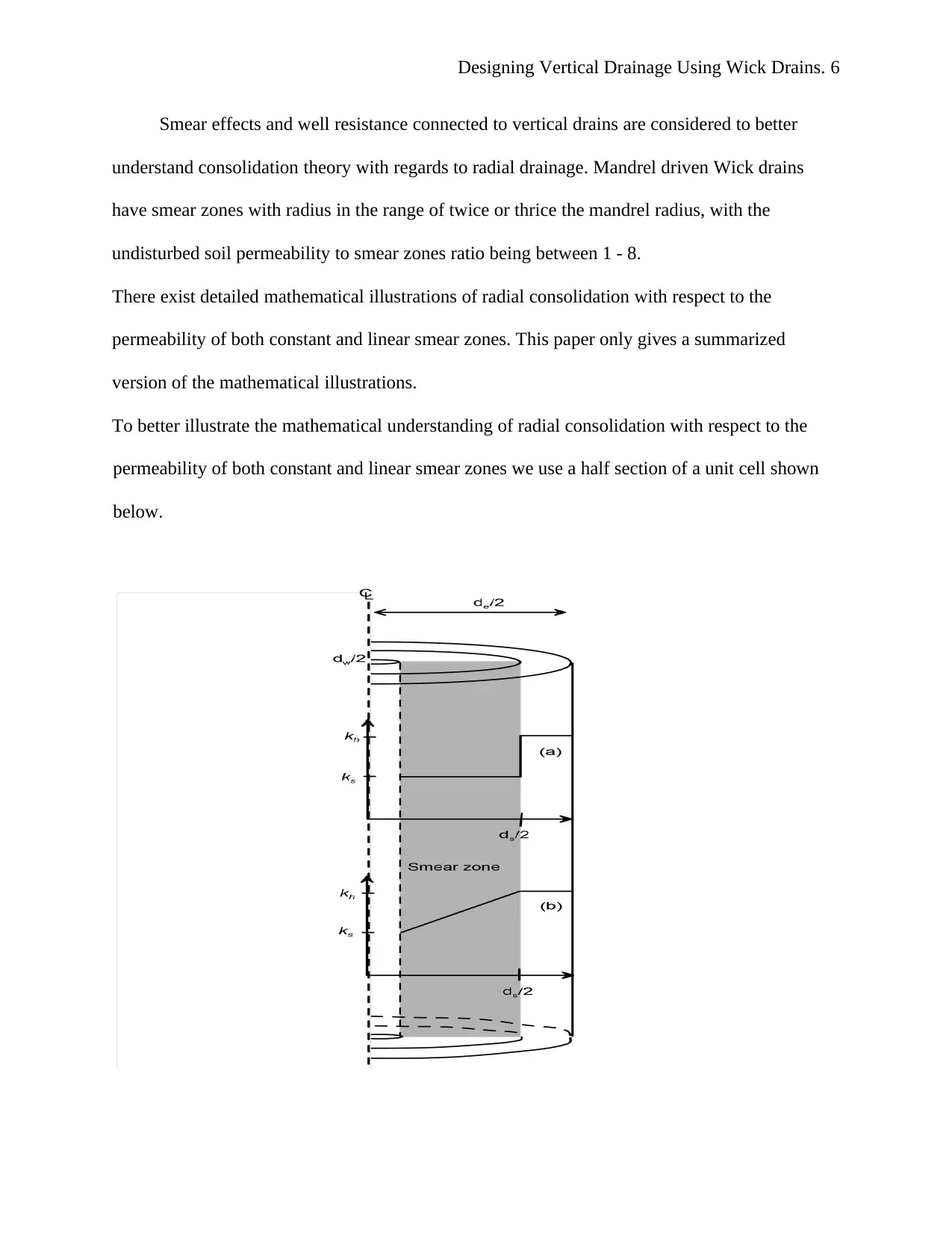
Smear effects and well resistance connected to vertical drains are considered to better
understand consolidation theory with regards to radial drainage. Mandrel driven Wick drains
have smear zones with radius in the range of twice or thrice the mandrel radius, with the
undisturbed soil permeability to smear zones ratio being between 1 - 8.
There exist detailed mathematical illustrations of radial consolidation with respect to the
permeability of both constant and linear smear zones. This paper only gives a summarized
version of the mathematical illustrations.
To better illustrate the mathematical understanding of radial consolidation with respect to the
permeability of both constant and linear smear zones we use a half section of a unit cell shown
below.
Designing Vertical Drainage Using Wick Drains. 6
understand consolidation theory with regards to radial drainage. Mandrel driven Wick drains
have smear zones with radius in the range of twice or thrice the mandrel radius, with the
undisturbed soil permeability to smear zones ratio being between 1 - 8.
There exist detailed mathematical illustrations of radial consolidation with respect to the
permeability of both constant and linear smear zones. This paper only gives a summarized
version of the mathematical illustrations.
To better illustrate the mathematical understanding of radial consolidation with respect to the
permeability of both constant and linear smear zones we use a half section of a unit cell shown
below.
Designing Vertical Drainage Using Wick Drains. 6
⊘ This is a preview!⊘
Do you want full access?
Subscribe today to unlock all pages.

Trusted by 1+ million students worldwide
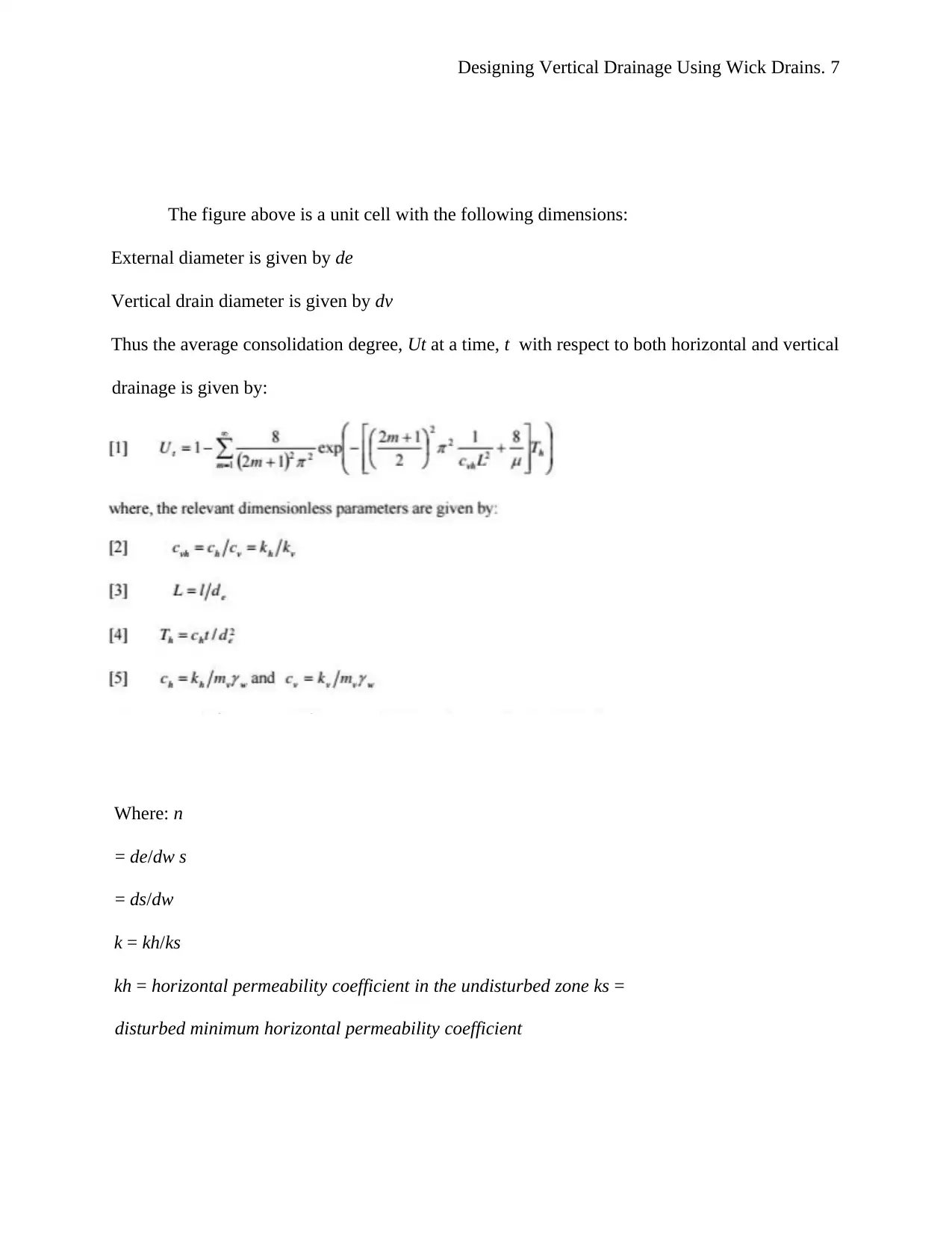
The figure above is a unit cell with the following dimensions:
External diameter is given by de
Vertical drain diameter is given by dv
Thus the average consolidation degree, Ut at a time, t with respect to both horizontal and vertical
drainage is given by:
Where: n
= de/dw s
= ds/dw
k = kh/ks
kh = horizontal permeability coefficient in the undisturbed zone ks =
disturbed minimum horizontal permeability coefficient
Designing Vertical Drainage Using Wick Drains. 7
External diameter is given by de
Vertical drain diameter is given by dv
Thus the average consolidation degree, Ut at a time, t with respect to both horizontal and vertical
drainage is given by:
Where: n
= de/dw s
= ds/dw
k = kh/ks
kh = horizontal permeability coefficient in the undisturbed zone ks =
disturbed minimum horizontal permeability coefficient
Designing Vertical Drainage Using Wick Drains. 7
Paraphrase This Document
Need a fresh take? Get an instant paraphrase of this document with our AI Paraphraser
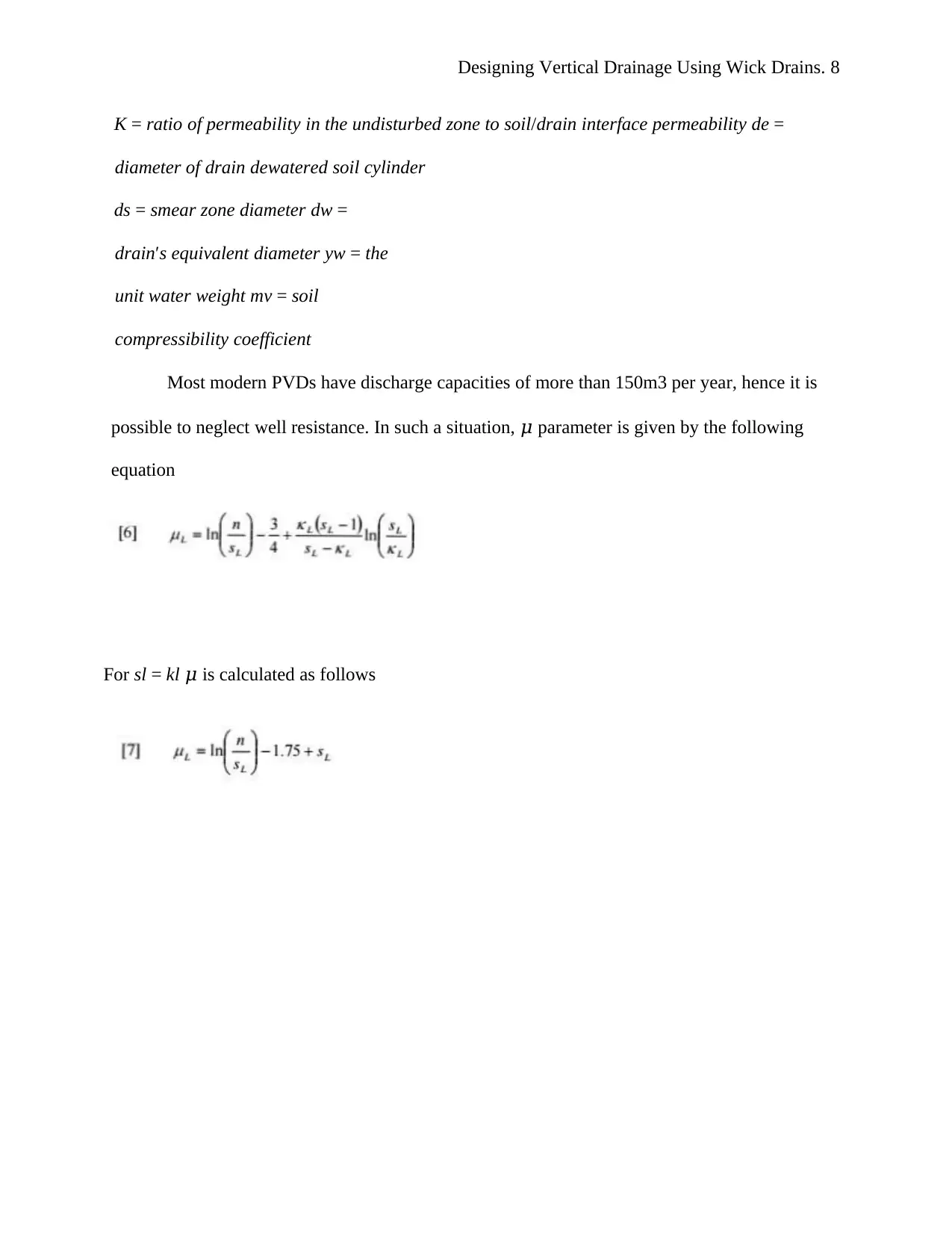
K = ratio of permeability in the undisturbed zone to soil/drain interface permeability de =
diameter of drain dewatered soil cylinder
ds = smear zone diameter dw =
drain′s equivalent diameter yw = the
unit water weight mv = soil
compressibility coefficient
Most modern PVDs have discharge capacities of more than 150m3 per year, hence it is
possible to neglect well resistance. In such a situation, 𝜇 parameter is given by the following
equation
For sl = kl 𝜇 is calculated as follows
Designing Vertical Drainage Using Wick Drains. 8
diameter of drain dewatered soil cylinder
ds = smear zone diameter dw =
drain′s equivalent diameter yw = the
unit water weight mv = soil
compressibility coefficient
Most modern PVDs have discharge capacities of more than 150m3 per year, hence it is
possible to neglect well resistance. In such a situation, 𝜇 parameter is given by the following
equation
For sl = kl 𝜇 is calculated as follows
Designing Vertical Drainage Using Wick Drains. 8
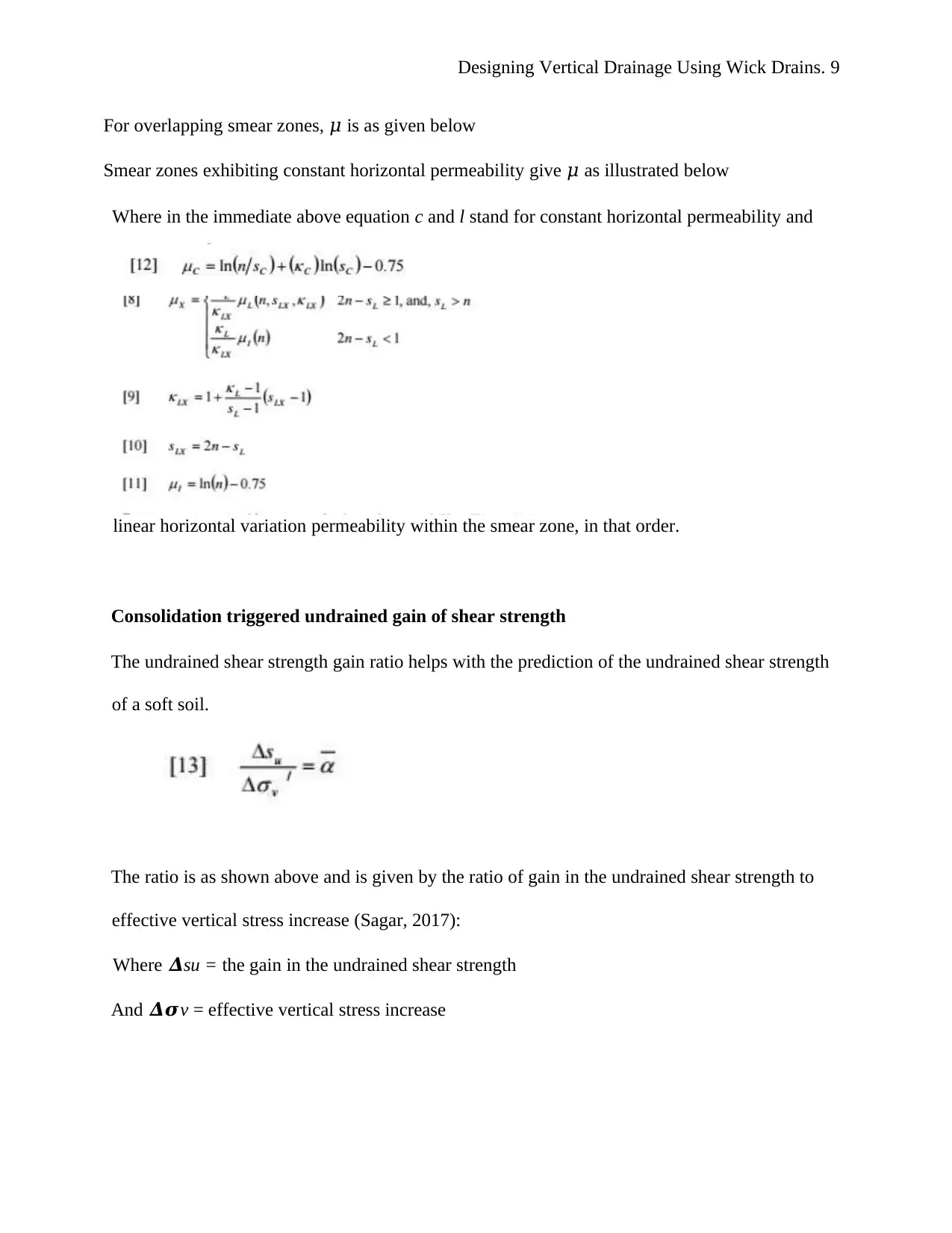
For overlapping smear zones, 𝜇 is as given below
Smear zones exhibiting constant horizontal permeability give 𝜇 as illustrated below
Where in the immediate above equation c and l stand for constant horizontal permeability and
linear horizontal variation permeability within the smear zone, in that order.
Consolidation triggered undrained gain of shear strength
The undrained shear strength gain ratio helps with the prediction of the undrained shear strength
of a soft soil.
The ratio is as shown above and is given by the ratio of gain in the undrained shear strength to
effective vertical stress increase (Sagar, 2017):
Where 𝜟su = the gain in the undrained shear strength
And 𝜟𝝈v = effective vertical stress increase
Designing Vertical Drainage Using Wick Drains. 9
Smear zones exhibiting constant horizontal permeability give 𝜇 as illustrated below
Where in the immediate above equation c and l stand for constant horizontal permeability and
linear horizontal variation permeability within the smear zone, in that order.
Consolidation triggered undrained gain of shear strength
The undrained shear strength gain ratio helps with the prediction of the undrained shear strength
of a soft soil.
The ratio is as shown above and is given by the ratio of gain in the undrained shear strength to
effective vertical stress increase (Sagar, 2017):
Where 𝜟su = the gain in the undrained shear strength
And 𝜟𝝈v = effective vertical stress increase
Designing Vertical Drainage Using Wick Drains. 9
⊘ This is a preview!⊘
Do you want full access?
Subscribe today to unlock all pages.

Trusted by 1+ million students worldwide
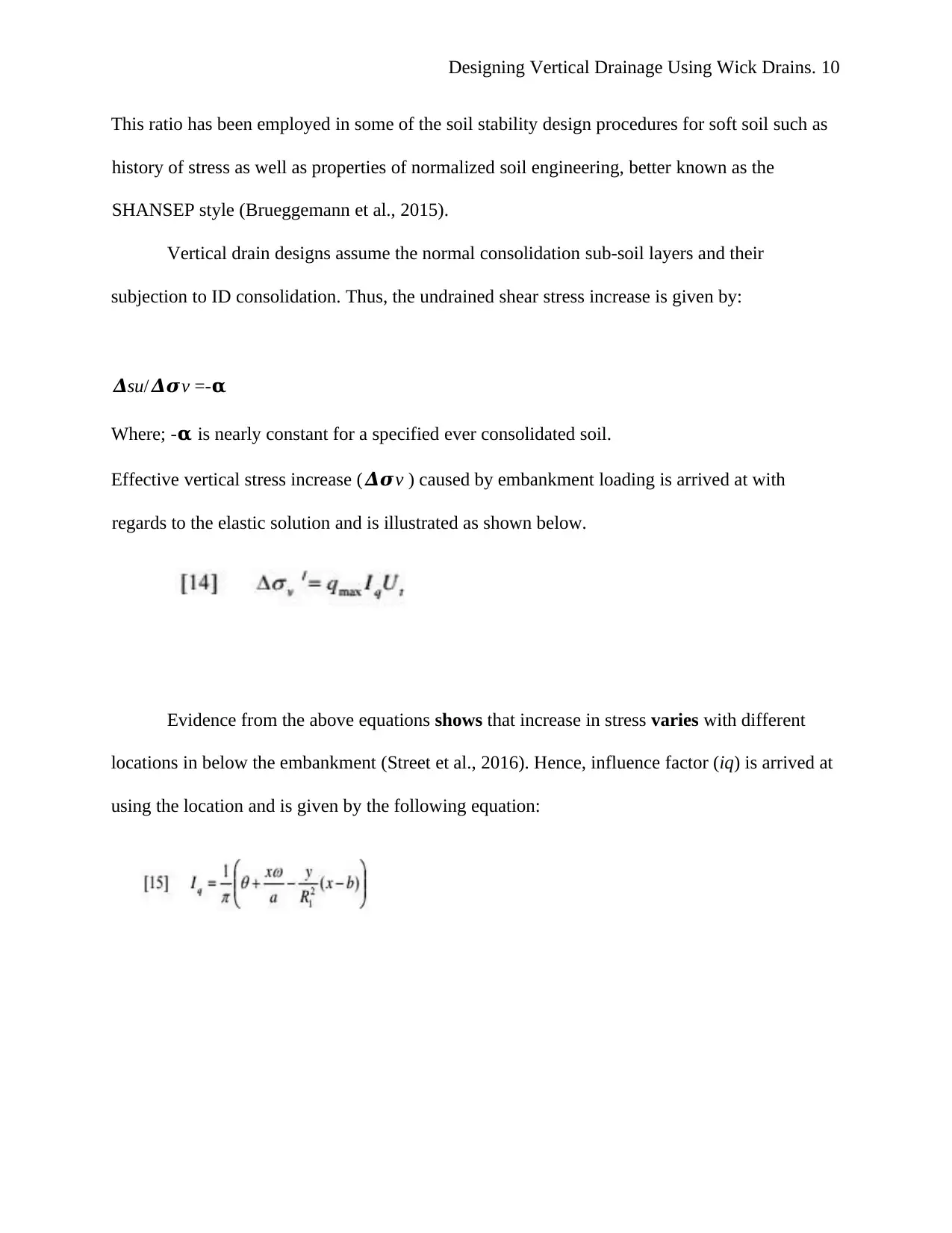
This ratio has been employed in some of the soil stability design procedures for soft soil such as
history of stress as well as properties of normalized soil engineering, better known as the
SHANSEP style (Brueggemann et al., 2015).
Vertical drain designs assume the normal consolidation sub-soil layers and their
subjection to ID consolidation. Thus, the undrained shear stress increase is given by:
𝜟su/𝜟𝝈v =-𝛂
Where; -𝛂 is nearly constant for a specified ever consolidated soil.
Effective vertical stress increase (𝜟𝝈v ) caused by embankment loading is arrived at with
regards to the elastic solution and is illustrated as shown below.
Evidence from the above equations shows that increase in stress varies with different
locations in below the embankment (Street et al., 2016). Hence, influence factor (iq) is arrived at
using the location and is given by the following equation:
Designing Vertical Drainage Using Wick Drains. 10
history of stress as well as properties of normalized soil engineering, better known as the
SHANSEP style (Brueggemann et al., 2015).
Vertical drain designs assume the normal consolidation sub-soil layers and their
subjection to ID consolidation. Thus, the undrained shear stress increase is given by:
𝜟su/𝜟𝝈v =-𝛂
Where; -𝛂 is nearly constant for a specified ever consolidated soil.
Effective vertical stress increase (𝜟𝝈v ) caused by embankment loading is arrived at with
regards to the elastic solution and is illustrated as shown below.
Evidence from the above equations shows that increase in stress varies with different
locations in below the embankment (Street et al., 2016). Hence, influence factor (iq) is arrived at
using the location and is given by the following equation:
Designing Vertical Drainage Using Wick Drains. 10
Paraphrase This Document
Need a fresh take? Get an instant paraphrase of this document with our AI Paraphraser
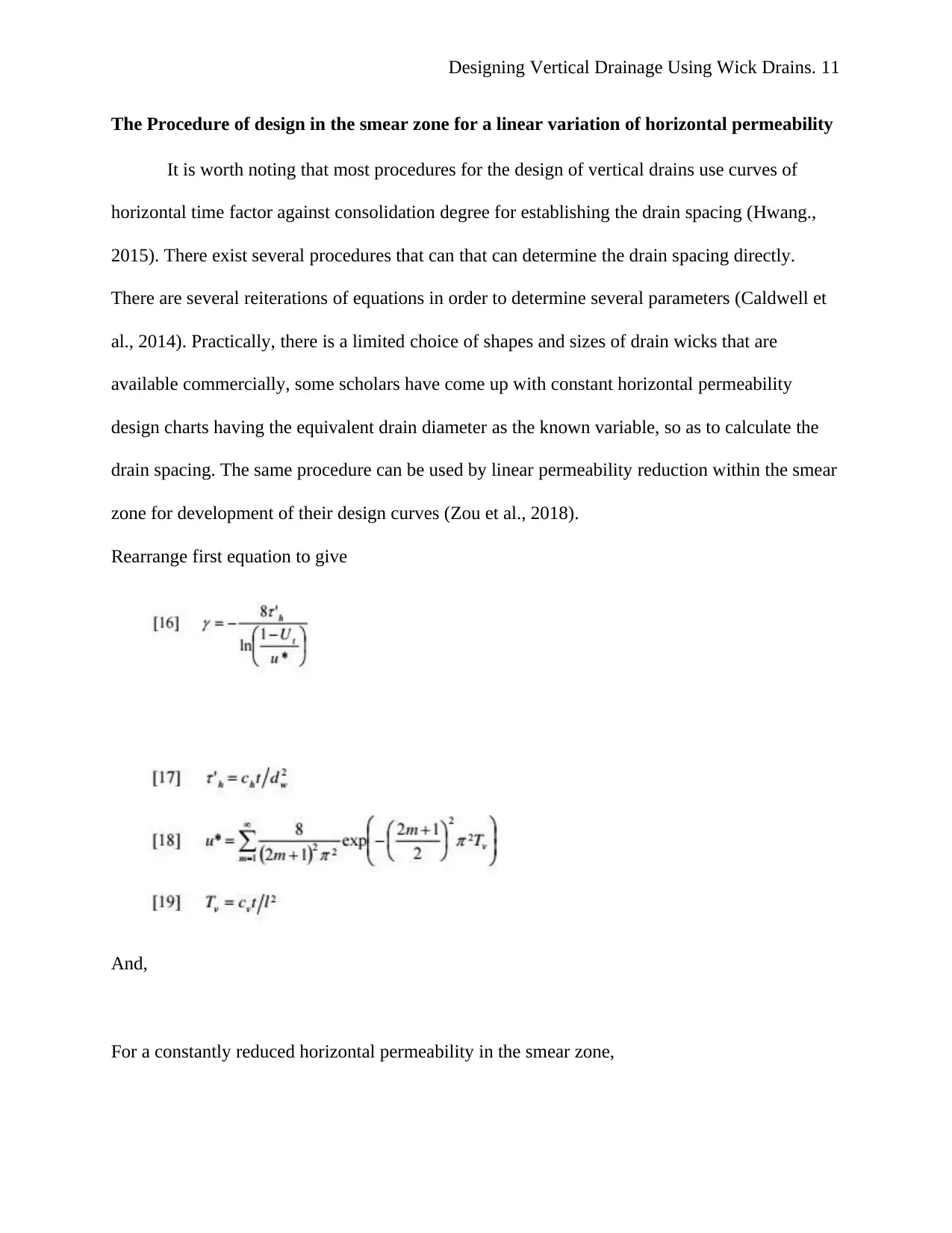
The Procedure of design in the smear zone for a linear variation of horizontal permeability
It is worth noting that most procedures for the design of vertical drains use curves of
horizontal time factor against consolidation degree for establishing the drain spacing (Hwang.,
2015). There exist several procedures that can that can determine the drain spacing directly.
There are several reiterations of equations in order to determine several parameters (Caldwell et
al., 2014). Practically, there is a limited choice of shapes and sizes of drain wicks that are
available commercially, some scholars have come up with constant horizontal permeability
design charts having the equivalent drain diameter as the known variable, so as to calculate the
drain spacing. The same procedure can be used by linear permeability reduction within the smear
zone for development of their design curves (Zou et al., 2018).
Rearrange first equation to give
And,
For a constantly reduced horizontal permeability in the smear zone,
Designing Vertical Drainage Using Wick Drains. 11
It is worth noting that most procedures for the design of vertical drains use curves of
horizontal time factor against consolidation degree for establishing the drain spacing (Hwang.,
2015). There exist several procedures that can that can determine the drain spacing directly.
There are several reiterations of equations in order to determine several parameters (Caldwell et
al., 2014). Practically, there is a limited choice of shapes and sizes of drain wicks that are
available commercially, some scholars have come up with constant horizontal permeability
design charts having the equivalent drain diameter as the known variable, so as to calculate the
drain spacing. The same procedure can be used by linear permeability reduction within the smear
zone for development of their design curves (Zou et al., 2018).
Rearrange first equation to give
And,
For a constantly reduced horizontal permeability in the smear zone,
Designing Vertical Drainage Using Wick Drains. 11
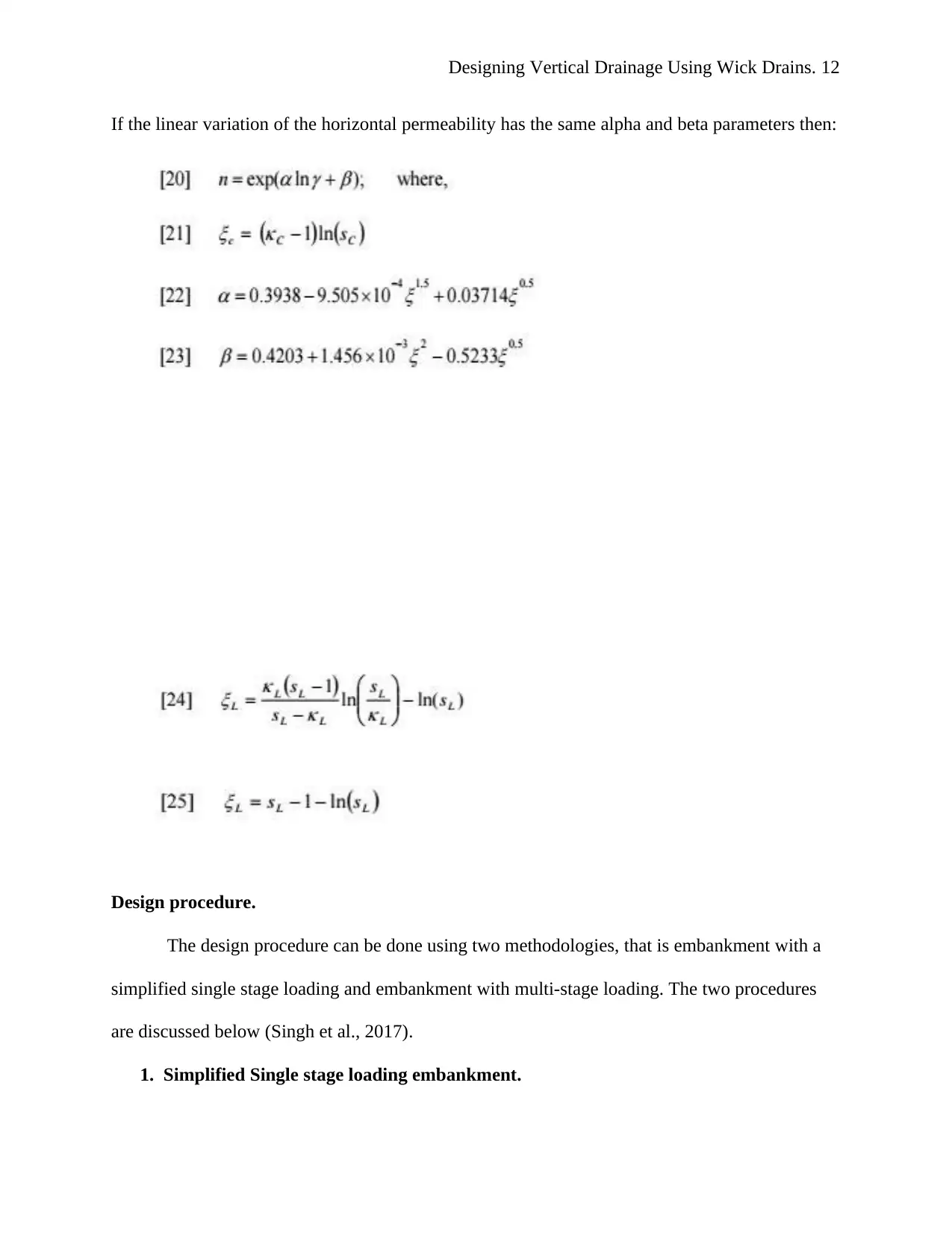
If the linear variation of the horizontal permeability has the same alpha and beta parameters then:
Design procedure.
The design procedure can be done using two methodologies, that is embankment with a
simplified single stage loading and embankment with multi-stage loading. The two procedures
are discussed below (Singh et al., 2017).
1. Simplified Single stage loading embankment.
Designing Vertical Drainage Using Wick Drains. 12
Design procedure.
The design procedure can be done using two methodologies, that is embankment with a
simplified single stage loading and embankment with multi-stage loading. The two procedures
are discussed below (Singh et al., 2017).
1. Simplified Single stage loading embankment.
Designing Vertical Drainage Using Wick Drains. 12
⊘ This is a preview!⊘
Do you want full access?
Subscribe today to unlock all pages.

Trusted by 1+ million students worldwide
1 out of 19
Your All-in-One AI-Powered Toolkit for Academic Success.
+13062052269
info@desklib.com
Available 24*7 on WhatsApp / Email
![[object Object]](/_next/static/media/star-bottom.7253800d.svg)
Unlock your academic potential
Copyright © 2020–2025 A2Z Services. All Rights Reserved. Developed and managed by ZUCOL.

